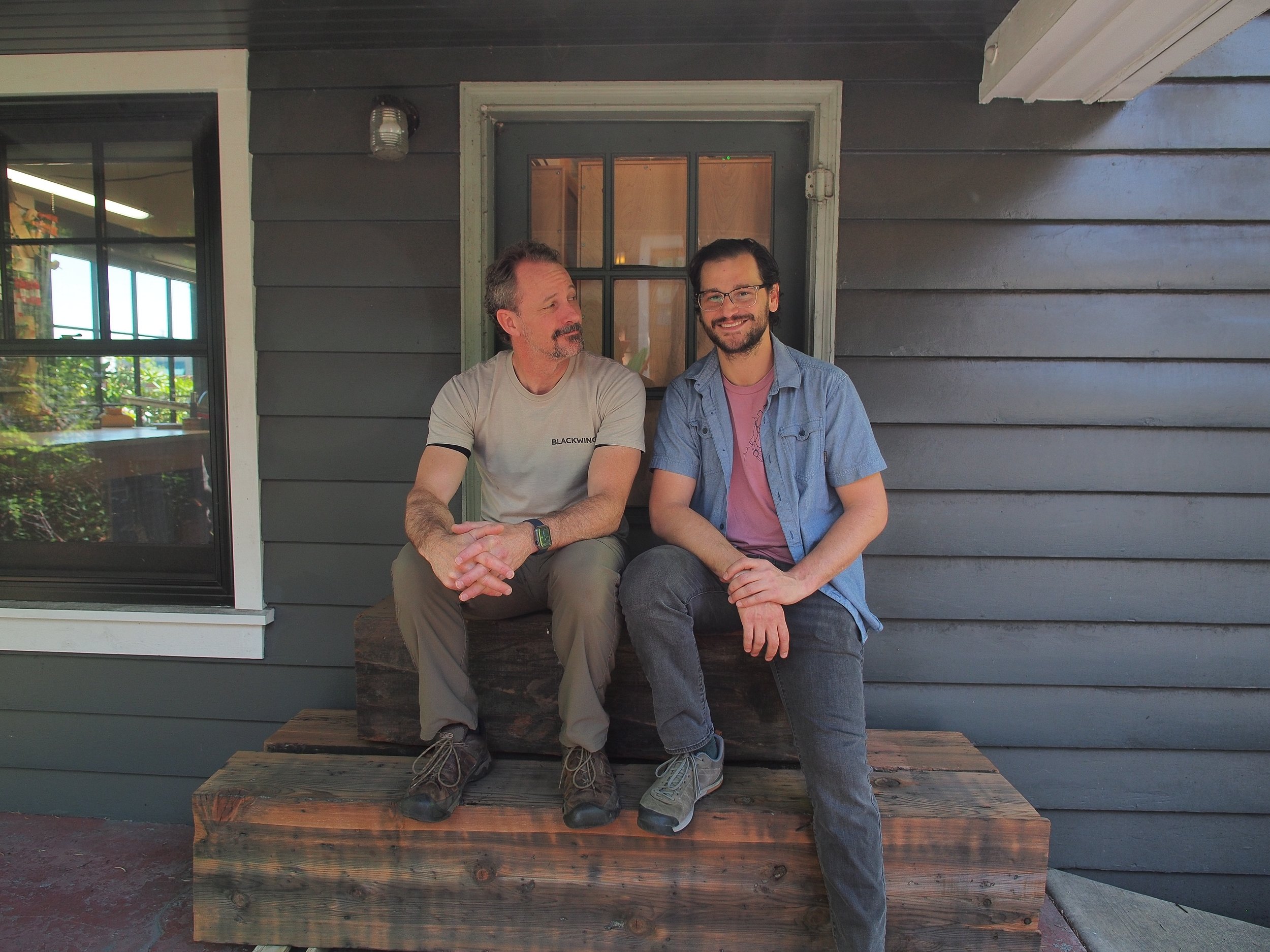*** The “LTR Store” is now officially closed for the remainder of 2023. We plan on getting our hands on more rough timbers to process in the Spring of 2024, but will need to focus on other shop priorities as well. Thank you to everyone that made the second round of LTR sales absolutely amazing!! ***
Story
A little while back, my partner Adam Mendel and I embarked on an amazing venture. I got a tip from a good friend and client, Bill Irwin, about a long abandoned train line in Northern CA that was dotted with tunnels. With all the excitement surrounding Tunnel 13 and 14, and all the incredible guitar wood they both had already yielded, Bill thought there might be a chance that these abandoned tunnels may be the next source for redwood guitar tops. I drove down and picked up the first of what would end up being many huge redwood timbers, to see what we had. This first beam we ended up calling 1-A and 1-B since it had to be cut in half to process. It didn’t look like much, but, once the rough outer layer had been removed and we started cutting into it, we instantly realized we had something special. We got around 30 tops from that first beam, and I was fortunate to be the one to build the first completed guitar with what we dubbed a “Lost Tunnel Redwood” top. The description “old growth” is used rather loosely these days, but this stuff is just that. First growth redwood, from giant, mature trees. They were cut down over 150 years ago, milled and put in place by rail workers (probably of Chinese decent). The line has been abandoned for 25+ years now, and these truly old growth timbers have sat in place all that time. Getting them out isn’t easy, and is just the beginning. It can be dangerous, and it is incredibly difficult and labor intensive work. Each 4’ section can weigh up to 80lbs., and it’s quite common to have to haul around much larger sections, up to 20’! Then, they’re transported back to my shop where they are “skinned” (removal of the outer layer to see what we can see), rough milled into quartered billets, resawn, sanded clean to 150grit, templated, graded, and provided to you. I have been working in the guitar world for 30 years now, and these are some of the most special tops I have ever encountered.
Grading
Grading is no easy subject. However, we feel that the wood we are dealing with sits somewhat above modern grading practices. This wood is VERY old, VERY stable, and of a character and quality that you just don’t see as often any more, consequently making grading rather easy for us. As I said above, I’ve been at this for 30+ years now, and this is some of the best material I have ever worked with. We offer three primary categories: 2A, 3A, and Master. And, when we feel we are at an impasse between two grades, we default to the lower grade to benefit the buyer. Note… All of the tops we are selling for Uke are what we would consider Master grade.
Master
This is the absolute best of the best. A Master top must be stiff, uniform in color and grain, and possess a high level of figure, rays, flecks, or all of the above. These are tops that we are considering to be as close to perfect as Mother Nature can provide.
3A
By most grading standards, our 3A tops could easily fall into the Master category. However, we feel that if there is even just one minor issue (almost always cosmetic), the top should be bumped from Master to 3A. This could be something as simple as a mineral line that is a slight shade darker from one side to the other, which could actually even sand out in the build process. Our 3A tops are absolutely professional grade, and would be a wonderful material for anyone, at any level, to build with.
2A
One step below 3A, usually due to some cosmetic issue. Our 2A tops could easily fall into most modern grading systems’ 3A, and is still a very high quality material. 2A tops may have a dark line in an otherwise lighter colored top, mineral lines that don’t match perfectly from one slice to the next, or a light knot shadow. What is in the template though, is professional and completely fine to build with at nearly all levels. These tops would make an excellent candidate for color work or sunburst, which could potentially end up making them Master tops anyway!
One final note on grading…
Within each top, or each beam to be more accurate, are dozens of visual details that could be considered good or bad depending on the builder considering. Things that we feel are PURELY visual, that one builder may love while another builder could hate, will not downgrade a top. For instance, a top that has repeating winter grain lines between repeating tighter grain bands, but looks homogenous and uniform, would not take a top from 3A to 2A. Nor would a top with mineral lines that are completely uniform, and do not detract from the overall beauty of the top. These kinds of visual characteristics are more up to the builder and what they are looking for. Details such as these will be called out in each individual Beam description, as well as things like density, weight, stiffness, color, figure, flecking, etc.
Sizing
Template sizes:
D/OM+ This size will easily fit a D and OM size with PLENTY of room to spare. Most have enough room to fit an 18” lower bout width, and some as large as 20”,
OM L: 20”, UB: 11.5”, LB: 15.25”, W: 9.25”
00-14 L: 19”, UB: 11”, LB: 14.5”, W: 9”
0-14 L: 18.5”, UB: 10”, LB: 13.5”, W: 8.25”
Uke Barritone L: 14.25”, UB: 7.5”, LB: 10”, W: 6.5”
Uke Tenor L: 12.5”, UB: 6.5”, LB: 9”, W: 5.5”
Additional Notes:
*All of these tops have been templated for 14 fret models only. If interested in a 12 fret version, please ask to make sure they will work.
*Typically, the template lines we provide are a good bit outside of the ACTUAL top perimeter. However, we still grade based on whatever is within our lines provided.
*Most of our tops ship in the 0.200-0.225” range. Plenty of thickness for joining, rosette, and anything else you may need. Only a few tops out of the 200 we have for sale are thinner than that, but still well within safe build dimensions, maybe 0.165” at the thinnest. If this is a problem, please specify at the time of purchase. Uke tops are generally in the 0.150-0.170” range.
*The center seams have been finely jointed, but we would still recommend shooting with a sharp plane and candling prior to glue up.
Shipping
Packing and shipping over 200 tops is going to take time and energy. We appreciate you granting us some time to get every order packed and shipped out at the same time rather than addressing each order individually. I’m not sure exactly how long that will take, but we will send out a shipping notification as soon as it’s all ready. Patience please.




